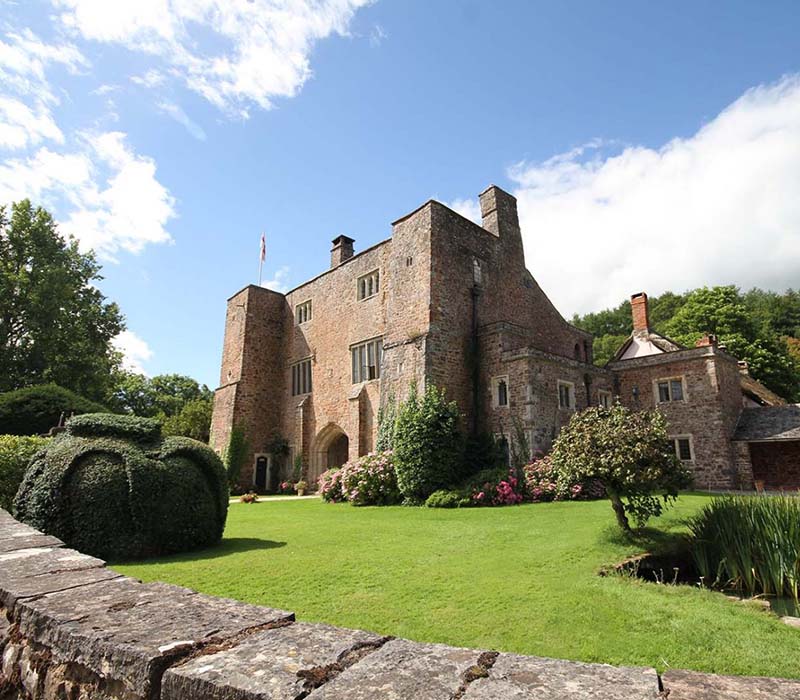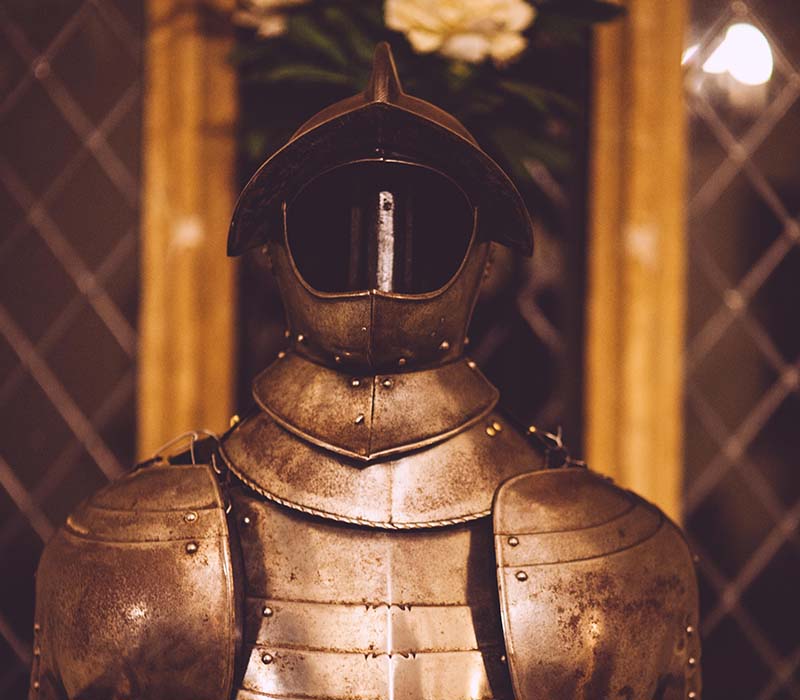THE CASTLE DATES BACK AS FAR AS 600AD
Take a step into a Devon Castle in the countryside by booking one of our Castle tours today. We’re pleased to offer guided castle tours of Bickleigh Castle. Learn about the history and hear some of the intriguing stories associated with it from one of our expert historians. See just some of information on the history of our Castle below.

The Historical timeline
- 600 AD The Saxon Meeting House (now the Chapel) was first built.
- 800 AD The Meeting House became the Parish Church.
- 1018 The original ‘Motte & Bailey’ construction was built to defend the Bickleigh community, which included cottages and a Saxon Manor House.
- 1050 A meeting was held in the Saxon Manor House concerning the apportionment of land in Devon, chaired by King Edward the Confessor.
- 1080s Bickleigh Castle was listed in the Domesday Book (1086) and the lands of some 3000 acres subsequently granted to Sir Richard de Redvers by King William I. A substantial Norman fortress was built, which included an inner and outer keep, moat and castellations.
- 1096-1099 The First Crusade after which Jocelyn de Courtenay, ancestor of the Bickleigh Courtenays, was made Emperor of Edessa (in what is now Iraq) and Constantinople.
- 1140s Bickleigh Castle & the de Redvers family were embroiled in a Civil War in which the Castle was severely damaged by King Stephen’s army.
- Baldwin de Redvers, 1st Earl of Devon and a great landowner, tenanted Bickleigh to the de Balvago family. His grand-daughter Isabella, who lived to a great age, was a magnate in her own right and owned the Isle of Wight (known as the ‘Lady of the Isle’) which she bequeathed to the King.
- The Courtenay family took over, in 1292, from the de Redvers family through the Estates being passed from the Lady Isabella to her second cousin once removed Hugh de Courtenay. A point of interest is that Hugh de Courtenay became 1st Baron Courtenay in 1298 and Earl of Devon in 1336.
- The new parish church was built across the valley (St Mary the Virgin, Bickleigh) and it is thought the original font from what is now the Castle Chapel was gifted for the new Church. From then to the present day (except for a period in the 19th Century as a cattle shed) the former parish church has been the domestic Chapel to the Castle.
- Also in the 1300s, a large ‘tithe barn’ was built at the Castle (on a site near the current car park) which lasted until the 19th Century; during the period up to the English Civil War (at least) this doubled as the wagon store.
- Subsequently, Bickleigh was tenanted to the family Poyntingdon about which there was a lawsuit in the 1350s in the High Court, which found in favour of Poyntingdon. Eventually, however, Bickleigh was used (see 9 below) as one of the principal Courtenay residences .
- Lady Margaret de Bohun, Countess of Devon (3 April 1311 – 16 December 1391), was the grand-daughter of King Edward I and Eleanor of Castile, and the wife of Hugh Courtenay, 10th Earl of Devon (1303-1377) – their tomb is in the South Transept of Exeter Cathedral. Her thirteen children included an Archbishop of Canterbury and six knights, of whom two were founder knights of the Order of the Garter. Unlike most women of her day, she received a classical education and was a lifelong scholar and collector of books.
- 1400s King Henry VII’s great-aunt, Lady Margaret Beaufort, sister of the Duke of Somerset and spouse of Thomas Courtenay, 5th Earl of Devon, lived at Tiverton and Bickleigh Castles.
- 1400s Bickleigh Castle was remodeled as a comfortable and substantial fortified Manor House by Lord Thomas and Lady Margaret. This included installation of larger windows and fireplaces, a substantial Manor House built on the site of the current tennis court and attached to the inner Keep of the original castle, a large stable block with facilities where the current walled garden is, and a Magistrates’ Court, which still stands, known now as ‘Old Court’ and probably other auxiliary buildings.
- 1400s all three sons of Lord Thomas and Lady Margaret were killed in The Wars of the Roses, one executed for treason, one as a prisoner of war, and one killed in the Battle of Tewkesbury 1471.
- 1495 Sir William Carew Bt, became tenant of Bickleigh (by then owned by his cousin Sir Philip Courtenay). In 1505 was born George Carew, who became Admiral Sir George Carew, famous for drowning in the capsizing and sinking of ‘The Mary Rose’ at The Spithead in 1545.
- 1512 Sir William’s ward, Elizabeth Courtenay eloped with Sir William’s younger brother Thomas; Thomas, at the Battle of Flodden Field, 1513, saved the life of the commander, the Lord Admiral Lord Howard, by exchanging armour with him and being taken prisoner. Eventually released, Thomas was created an honorary Vice-Admiral. After this, Elizabeth’s aged grandfather Sir Philip Courtenay bequeathed the whole Bickleigh estate to the Carews, who then owned it until 1924.
- Henry VIII’s favourite aunt, Princess Katherine Plantagenet (daughter of King Edward IV) at the same time lived at Tiverton Castle; when her husband William Courtenay, Earl of Devon, died in 1511 she spent much time at Bickleigh Castle as the guest of her relation-by-marriage, Elizabeth as mentioned above. Princess Katherine was apparently fond of children, and entertained those of courtiers and royalty, including, according to one source, Ann Boleyn. Princess Katherine died in 1527 and after a semi-state funeral in St Peter’s Church, Tiverton, was buried there, where her tomb can be seen to this day.
- Princess Katherine’s son Henry, Marquess of Exeter, was implicated in the Exeter Conspiracy (against the Reformation) of 1538 and executed at the Tower. Tiverton was forfeit to the Crown and was never a Courtenay property again.
- Further improvements to Bickleigh came in the late 16th and early 17th Centuries, and it was early in this period that the Bickleigh Frieze, depicting the demise of Henry Courtenay and other aspects of the Reformation in stone, was created, during the ownership of Sir Peter Carew. This is in the private area but a photograph of it hangs in the public area.
- Moving on to the English Civil War of the 1640s, Queen Henrietta Maria (wife of King Charles 1, known to the people as ‘Queen Mary’) stayed at Bickleigh Castle in 1644 as a guest of Sir Henry Carew, Kt., & Lady Dorothy, on her way to stay with Lord Russell at Bedford House in Exeter, where she gave birth to her youngest daughter, Princess Henrietta Anne (‘Minette’), christened in the Cathedral 21st July 1644. The King came down to Exeter for the Christening, arriving several days late, and remained in Exeter for two weeks. The Queen had already exiled herself to Paris (to evade capture) and ‘Minette’ was smuggled over by her mother’s lady-in-waiting two years later. Several items from the Queen’s Baggage eventually ended up at Bickleigh Castle.



- 1646, Spring – the Castle was attacked by the New Model Army under General Sir Thomas Fairfax, and the main manor house and inner keep were destroyed completely. This was called ‘the slighting of Bickleigh’ which meant only part of the estate was destroyed (unfortunately the main part). Sir Henry & Lady Dorothy died in 1677 and 1681 respectively, after building some of the cottages which are now the main accommodation at Bickleigh (an Act of Parliament preventing the rebuilding of the castle). There are some interesting memorials and effigies of the Carews in the Parish Church. From the late 18th Century until 1927, Bickleigh was mainly tenanted to farmers.
- 1933-57 The Castle (including 1600 acres, the Fisherman’s Cot and Bickleigh Mill) belonged to Lt.Colonel Jasper Henson, a World War 1 veteran who served in the Royal West Kent Regiment (‘The Queen’s’), and whose Battalion was in India in 1914. The Colonel did a great amount of restoration of the Castle, though the Chapel was restored in 1929 by the previous owners named Harper. The Colonel installed electricity (initially hydro-electric). The Colonel tended to replace ‘like with like’ hence some very good restoration work was done. After the restoration, the Colonel had six suits of armour made to adorn the castle, of which one remains on display (others being originals). The Castle also houses the colonel’s collection of cavalry swords
- After 1957 the Castle belonged to the Berkeley-Owen family until 1969, when the estate was advertised still with 1200 acres (unfortunately subsequently broken up). It was bought by Mr Boxall, whose son Michael took over the running of the estate in the 1980s.
- In 2002 the Castle was bought by the current owners who have had more restoration and enhancement work carried out. The new owners offer both weddings, bed and breakfast accommodation, hire of the castle and house parties.
Some interesting facts about Bickleigh Castle
- Bickleigh Castle is a stone’s throw from the bridge that – according to local legend – is where Simon and Garfunkel penned their classic hit ‘Bridge over troubled water’ in 1969.
- National figure and local ‘Robin Hood’, Bampfylde Moore Carew, aka ‘King of the Beggars’, whose mischiefs were captured in books such as Vanity Fair, is buried in an unmarked grave at Bickleigh Church and recorded in the Parish Register of 1758.
- There is a secret, completely sealed, room next to the Armoury – it is currently one of the Castle’s mysteries – what is inside? Lord Lucan? Gold? Secrets of the Crown? Perhaps we will find out one day.
- The Chapel was originally a Saxon meeting house, first built in the 6th Century, and was the parish church until the 1400s, after which it was the estate chapel. During the 19th Century it was used as a cattle shed, before being restored in 1929. It was reconsecrated in 1933 by the Bishop of Exeter.
- There is an original suit of armour made for and worn by King Charles I. It came to Bickleigh when Queen Henrietta Maria visited as a guest of Sir Henry Carew and is from her baggage train which stayed behind when she had to leave the country.
- The main character in the BBC drama series White Queen, Margaret Beaufort, mother of King Henry VII, had a aunt of the same name who resided at Bickleigh Castle in the 1400s.

Some of Our Testimonials
- Have just come back from a wonderful weekend visit at Bickleigh Castle. All the staff are friendly and welcoming. The property is amazing on beautiful grounds. Our room was a great room, clean and lovely and all you could want. There was a great choice at breakfast and loved the guided tour we were given of the castle. I can’t recommend this property enough. Thanks for a great weekend! - lcastle87
- Just got back from our 2nd visit to the wonderful Bickleigh Castle. It is such a beautiful place and we have enjoyed every moment spent there.We were made really welcome by Sarah Robbie and John and all of the staff were very friendly and helpful. The breakfast was outstanding and the rooms were spacious and comfortable. - Ken & Lyn Colmer
- We booked the castle as we had it recommended to us. We were thrilled with the thatched cottage that we stayed in. The room was lovely with 2 queen sized beds. We noticed straight away that the bedding was luxurious. Warm fluffy towels in the bathroom. The view was amazing. The family that run it were warm and welcoming and were happy to chat and make us feel at ease. - Helen H
